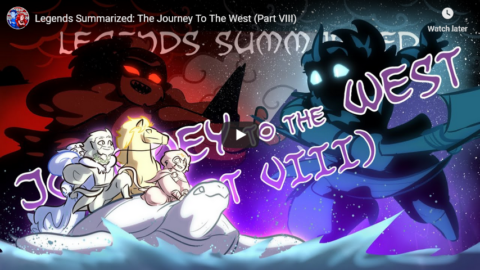The programmes of the Two Minutes Hate varied from day to day, but there was none in which Goldstein was not the principal figure … Somewhere or other he was still alive and hatching his conspiracies: perhaps somewhere beyond the sea, under the protection of his foreign paymasters, perhaps even — so it was occasionally rumoured — in some hiding-place in Oceania itself …
Goldstein was delivering his usual venomous attack upon the doctrines of the Party — an attack so exaggerated and perverse that a child should have been able to see through it, and yet just plausible enough to fill one with an alarmed feeling that other people, less level-headed than oneself, might be taken in by it …
The sight or even the thought of Goldstein produced fear and anger automatically … But what was strange was that although Goldstein was hated and despised by everybody, although every day and a thousand times a day, on platforms, on the telescreen, in newspapers, in books, his theories were refuted, smashed, ridiculed, held up to the general gaze for the pitiful rubbish that they were — in spite of all this, his influence never seemed to grow less. Always there were fresh dupes waiting to be seduced by him. A day never passed when spies and saboteurs acting under his directions were not unmasked by the Thought Police.
George Orwell, Nineteen Eighty-Four, 1949.
April 14, 2021
QotD: Emmanuel Goldstein, the Enemy of the People
April 5, 2021
Did the Trojan War Really Happen?
Kings and Generals
Published 13 Aug 2020Kings and Generals’ historical animated documentary series continues with a video on the Trojan War, as we talk about the historicity of the conflict between Trojans and the Greeks depicted in the immortal Iliad of Homer. We also cover the Mycenaean and Hittite civilizations. How did this story come to be? Is it just a myth or is there historical proof that it happened? What does archeology tell us about the conflict at the end of the Bronze age? Were Hector, Achilles, Helen and Paris even real?
Support us on Patreon: http://www.patreon.com/KingsandGenerals or Paypal: http://paypal.me/kingsandgenerals We are grateful to our patrons and sponsors, who made this video possible: https://docs.google.com/document/d/1o…
Art and animation: Oğuz Tunç http://bit.ly/2H6oRjw
Script: Leo Stone
Narration: Officially Devin (https://www.youtube.com/user/OfficiallyDevin)
Merch store ► teespring.com/stores/kingsandgenerals
Podcast ► Google Play: http://bit.ly/2QDF7y0 iTunes: https://apple.co/2QTuMNG
Twitter ► https://twitter.com/KingsGenerals
Instagram ► http://www.instagram.com/Kings_Generals
Production Music courtesy of Epidemic Sound: http://www.epidemicsound.com
#Documentary #Troy #Greece
February 14, 2021
QotD: Pauline Réage’s Story of O
I’m sitting on a plane and I’m feeling increasingly excited. I’m flushed. My heart rate is up, and I can’t seem to find a comfortable way to sit. My agitation isn’t caused by any nervousness about flying, nor by any fears of contracting COVID-19 during the flight. My disquiet has been triggered by the book I’m reading. The sensations it arouses almost overwhelm me. I find I have to pause every few paragraphs, close the slim volume, and rest it on my lap in order to regain some sense of personal composure. Fiction usually transports my imagination away from myself, but this book is accomplishing the opposite: I feel increasingly aware of my body as I read it, as though being immersed in fiction has drawn me into a moment of privacy with myself. It feels somehow unseemly for the public world of the airplane to intrude on my private sensations. I have to put the book down frequently in order to remind myself that it is no act of indecency for the happy family sitting down the aisle from me to be talking casually, but rather that it is my own sense of secrecy that must be reconciled to the ordinary world around me.
I am reading Story of O, a novel written in 1954 that recounts the titular character’s journey into sexual bondage, violent penetrations, beatings, whippings, burnings, chains, gags, and dungeons. Readers only familiar with the pedestrian 1975 adaption are advised not to be put off — director Just Jaeckin’s film benefits from the lovely Corinne Cléry’s beguiling performance in the title role, but his soft-focus softcore aesthetic (gauzy white linen dresses and a smooth classical guitar soundtrack) miss the tenderness, the elegance, and the literary grace of the source. Graham Greene described Story of O as a “rare thing, a pornographic book well written and without a trace of obscenity”; Brian Aldiss remarked that O makes “pornography (if that is what it is) an art”; even JK Rowling has offered praise for the book, observing that, “If you’ve read Story of O you’ve kind of read the ultimate.” But it is JG Ballard’s description of the novel as “a deeply moral homily … touched by the magic of love” that resonates most powerfully with me. O is a radical instruction in morals (the book has a clear sense of feminine virtue, for one thing), and yet this sexual morality is unlike any I can find in our contemporary expression of sexual ethics, where self-expression is valued more than self-giving.
O is the story of a woman objectified and humiliated, of a woman who submits to being violated by the countless tongues and phalluses and fingers which enter her. The novel is more sensual than suspenseful — although there is a clear narrative, it is not a story driven by plot, but rather by a series of erotic episodes (Geraldine Bedell writing for the Observer described them as written with “a hallucinatory, erotic intensity”). It is a psychologically as well as sexually penetrative story of surrender, of being mastered and of becoming enslaved, especially its first chapter which describes the elegant sexual tortures of the Chateau at Roissy, a kind of playboy mansion with fewer grottos and more dungeons.
It is here that, at the request of her lover René, O acquiesces in her complete submission. The cast of characters is sparse: O and René; Jacqueline, a young model whom O seduces, and Jacqueline’s 16-year-old sister, Natalie, a virgin eager to be initiated into the sexual rites of Roissy; Anne-Marie, an older and more ruthless mistress than are the many men at the Chateau; sundry blondes, brunettes, and redheads arranged alluringly throughout the text; and finally O’s ultimate lover, the sophisticated Sir Stephen, a kind of father-figure to René who ends up laying claim to O, flogging her, shackling her labia with an iron ring, and branding her with his initials as his slave, “a condition,” the narrator tells us, “of which O herself was proud.” As I read of the many exquisite ways O gives herself for men’s uses, I begin to wonder if the book was presenting me not with a picture of masculine sexual fantasies, but with a vision of my own.
The novel was written by the mysterious Pauline Réage, a pseudonym. In what is arguably one of the most successful literary secrets, Réage’s identity was kept hidden for decades. It wasn’t until 40 years after the novel’s publication that the then 86-year-old Dominique Aury, a respected editor and French intellectual, revealed that she was the author. It seems fitting that in a novel of sexual submission, Aury — Dominique, dominance, dominatrix — maintained such strict control over her own identity. Even Dominique Aury was not her “real” name: she was born Anne Desclos, but legally changed it in 1940. Aury’s nested names and identities are like a meta-fictitious exercise in un-making and making the self, for questions of self-identity and self-integrity lie at the heart of her novel.
Marilyn Simon, “My Own Private Chateau — Pauline Réage’s Story of O Revisited”, Quillete, 2020-10-18.
January 3, 2021
QotD: Literary stasis in the Byzantine empire
Undoubtedly, the Mediaeval Romans – now exclusively Greek in their language – made little effort to be original in their literature. They had virtually the whole body of Classical Greek literature in their libraries and in their heads. For them, this was both a wonderful possession and a fetter on the imagination. It was in their language, and not in their language. Any educated person could understand it. But the language had moved on – changes of pronunciation and dynamics and vocabulary. The classics were the accepted model for composition. But to write like the ancients was furiously hard. Imagine a world in which we spoke Standard English, but felt compelled, for everything above a short e-mail, to write in the language of Shakespeare and the Authorised Version of the Bible. Some of us might manage a good pastiche. Most of us would simply memorise the whole of the Bible, and, overlooking its actual content, write by adapting and rearranging remembered clauses. It would encourage an original literature. Because Latin soon became a completely foreign language in the West – and because we in England were so barbarous, we had to write in our own language – Western Mediaeval literature is often a fine thing. The Mediaeval Romans never had a dark age in our sense. Their historians in the fifteenth century wrote up the fall of Constantinople to the Turks in the same language as Thucydides. Poor Greeks.
Sean Gabb, “The Mediaeval Roman Empire: An Unlikely Emergence and Survival”, SeanGabb.co.uk, 2018-09-14.
December 26, 2020
Legends Summarized: The Journey To The West (Part VIII)
Overly Sarcastic Productions
Published 25 Dec 2020Journey to the West Kai, episode 5: Fishy Business and Mountaineering Madness!
Danger! Intrigue! Sandy fights a carp! Pigsy gets two makeovers! Monkey reunites with several old frenemies, and Tripitaka gets less screentime than the horse!
(merry christmas)
(Here’s a cheeky little bit of merch: https://www.redbubble.com/shop/ap/656…)
FIRST EPISODE: https://www.youtube.com/watch?v=61nuX…
PREVIOUS EPISODE: https://youtu.be/ABuG8hZqynI
FULL SERIES: https://www.youtube.com/playlist?list…Our content is intended for teenage audiences and up.
PATREON: https://www.Patreon.com/OSP
MERCH LINKS: https://www.redbubble.com/people/OSPY…
DISCORD: https://discord.gg/h3AqJPe
OUR WEBSITE: https://www.OverlySarcasticProductions.com
Find us on Twitter https://www.Twitter.com/OSPYouTube
Find us on Reddit https://www.Reddit.com/r/OSP/
December 12, 2020
QotD: Modernism
Don’t you think the whole effort of modernism — in architecture, in literature, in music, in painting — might have been a huge dead end, from which Western culture will painfully have to extricate itself?
Myron Magnet, “Free Speech in Peril: Trigger warning: may offend the illiberal or intolerant”, City Journal, 2015-04.
November 14, 2020
The Decline of the Great Library of Alexandria
The History Guy: History Deserves to Be Remembered
Published 27 Mar 2019Presented by Ms History. The Great Library was a center of knowledge. Its decline was not the single cataclysmic event that may seem to think, but its slow decline is perhaps, even more tragic. It is history that deserves to be remembered.
This is original content based on research by The History Guy. Images in the Public Domain are carefully selected and provide illustration. As images of actual events are sometimes not available, images of similar objects and events are used for illustration.
All events are portrayed in historical context and for educational purposes. No images or content are primarily intended to shock and disgust. Those who do not learn from history are doomed to repeat it. Non censuram.
Ms. History Guy is an avid reader and former reference librarian, and reviews around 100 books per year. Feel free to follow her progress or befriend her on Goodreads where she goes by the name “Heidi the Reader”: https://www.goodreads.com/MsHistory
Patreon: https://www.patreon.com/TheHistoryGuy
The History Guy: History Deserves to Be Remembered is the place to find short snippets of forgotten history from five to fifteen minutes long. If you like history too, this is the channel for you.
Awesome The History Guy merchandise is available at:
teespring.com/stores/the-history-guyScript by JCG
#history #thehistoryguy #library
October 16, 2020
“The Art of War” – Wisdom of Sun Tzu – Sabaton History 089 [Official]
Sabaton History
Published 15 Oct 2020Sun Tzu says: “The Art of War is of vital importance to the state. It is a matter of life and death, a road either to safety or to ruin.” The Chinese Art of War by Sun Tzu is one of the most influential books in history. Throughout the centuries it would accompany generals, statesmen, and philosophers alike. Those who follow his teachings, who safeguard themselves against defeat and make sure of victory before the battle is fought, will triumph. Those who know everything about themselves and their enemies will achieve supreme excellence.
The Art of War by Sun Tzu Text: https://www.gutenberg.org/files/132/1…
Support Sabaton History on Patreon: https://www.patreon.com/sabatonhistory
Listen to “The Art of War” on the album The Art of War:
https://music.sabaton.net/TheArtOfWarWatch the Official Live Clip of “The Art of War” here:
https://www.youtube.com/watch?v=aYoK1…Listen to Sabaton on Spotify: http://smarturl.it/SabatonSpotify
Official Sabaton Merchandise Shop: http://bit.ly/SabatonOfficialShopHosted by: Indy Neidell
Written by: Markus Linke and Indy Neidell
Directed by: Astrid Deinhard and Wieke Kapteijns
Produced by: Pär Sundström, Astrid Deinhard and Spartacus Olsson
Creative Producer: Maria Kyhle
Executive Producers: Pär Sundström, Joakim Brodén, Tomas Sunmo, Indy Neidell, Astrid Deinhard, and Spartacus Olsson
Community Manager: Maria Kyhle
Post-Production Director: Wieke Kapteijns
Editor: Karolina Dołega
Sound Editor: Marek Kaminski
Maps by: Eastory – https://www.youtube.com/c/eastory
Archive: Reuters/Screenocean – https://www.screenocean.comVisual Sources:
– Pictures of Ming Dinasty courtesy of Yprpyqp from Wikimedia
– Pictures from the period of Opium War courtesy of Massachusetts Institute of Technology © 2010 Visualizing Cultures
– Wellcome Images
– Major National Historical and Cultural Site in China
– Pictures of The Art of War book courtesy of vlasta2, bluefootedbooby on flickr.com
– Metmuseum
– Picture of Eastern Han Calvary courtesy of GaryLee Todd from Wikimedia
– Granger Archive
– Hallwyl Museum
– Nomura Art Museum
– The icons from The Noun Project: Man by vanila, Asian woman by Jaime Serra, Wise Man by Éléonore SabatéAll music by: Sabaton
An OnLion Entertainment GmbH and Raging Beaver Publishing AB co-Production.
© Raging Beaver Publishing AB, 2019 – all rights reserved.
June 23, 2020
Legends Summarized: The Journey To The West (Part VII)
Overly Sarcastic Productions
Published 27 Dec 2019Journey to the West Kai, episode 4: Trouble in Taoist Town!
Thrills! Excitement! Pigsy takes a bath! Sandy fights an alligator! Monkey helps Tripitaka cheat on a high-stakes game show! And as always, everyone forgets about the horse!
Our content is intended for teenage audiences and up.
PATREON: https://www.Patreon.com/OSP
MERCH LINKS: https://www.redbubble.com/people/OSPY…
DISCORD: https://discord.gg/hhAZA2z
OUR WEBSITE: https://www.OverlySarcasticProductions.com
Find us on Twitter https://www.Twitter.com/OSPYouTube
Find us on Reddit https://www.Reddit.com/r/OSP/
June 16, 2020
Legends Summarized: The Journey To The West (Part VI)
Overly Sarcastic Productions
Published 14 Dec 2018JOURNEY TO THE WEST KAI, EPISODE 3: FAMILY FEUD!
Action! Excitement! Faces from the past! Kuan Yin discovers an exciting new acupuncture technique! Pigsy is unexpectedly skilled at CPR!
PATREON: https://www.patreon.com/user?u=4664797
MERCH LINKS:
Shirts – https://overlysarcasticproducts.threa…
All the other stuff – http://www.cafepress.com/OverlySarcas…Find us on Twitter @OSPYouTube!
June 9, 2020
Legends Summarized: The Journey To The West (Part V)
Overly Sarcastic Productions
Published 9 Feb 2018JOURNEY TO THE WEST KAI, EPISODE 2: LOS DEMONIOS HERMANOS!
It’s yet another episode almost a year in the making! (sorry again
) Today our heroes face off against a deadly duo of conveniently color-coordinated scoundrels, equipped with an impressive array of sacred treasures! Will Monkey be able to prioritize the well-being of his friends over his love of shiny things? Probably not, but find out now!
PATREON: https://www.patreon.com/user?u=4664797
MERCH LINKS:
Shirts – https://overlysarcasticproducts.threa…
All the other stuff – http://www.cafepress.com/OverlySarcas…Find us on Twitter @OSPYouTube!
June 2, 2020
Legends Summarized: The Journey To The West (Part IV)
Overly Sarcastic Productions
Published 19 Mar 2017JOURNEY TO THE WEST KAI, EPISODE 1: SKELE-FUN!
It’s the episode almost a year in the making! (sorry
) The saga of the monk Tripitaka, his bodyguard the Monkey King, and the rest of his merry band of pilgrims continues in this dramatic episode! Friendships are tested! Unlikely heroes rise to the occasion! Somebody throws a punch!
PATREON: https://www.patreon.com/user?u=4664797
MERCH LINKS:
Shirts – https://overlysarcasticproducts.threa…
All the other stuff – http://www.cafepress.com/OverlySarcas…Find us on Twitter @OSPYouTube!
May 26, 2020
Legends Summarized: The Journey To The West (Part III)
Overly Sarcastic Productions
Published 13 Apr 2016At last! The saga continues, as our troupe of compadres grows from three to five and the story can REALLY get started!
In case you were wondering, this ISN’T the only origin of the five-man-band archetype, although it certainly accounts for a lot of the associated tropes. The Mahabharata is another classic example, with the five Pandava brothers filling out the classic roles very well.
HEADS UP! We have a twitter now! Find us at https://twitter.com/OSPyoutube for all your dorky book-humor needs!
May 19, 2020
Legends Summarized: The Journey To The West (Part II)
Overly Sarcastic Productions
Published 14 Jan 2016The eponymous Journey actually begins! Sure hope this doesn’t take another eighty-three chapters. OH WAIT
Sun Wukong is back, and better than ever! Or … well, or worse, depending on your point of view. He’s getting up to shenanigans again, which is generally pretty problematic — but you know what, he’s doing stuff, and that’s the important thing.
May 12, 2020
Legends Summarized: The Monkey King (Journey To The West Part 1)
Overly Sarcastic Productions
Published 1 Oct 2015Meet the progenitor of all brash, impulsive, superpowerful anime characters! Sun Wukong, the Monkey King and Great Sage, was the most impulsive of them all!
“Wreaking havoc in heaven is so much fun it should be illegal!” -Monkey, probably
I might cover something else before continuing with part two of The Journey To The West. It’s kind of a doozy, and I’m having a lot of trouble convincing myself to cut some parts out. Watch out for Don Quixote in the meantime.














